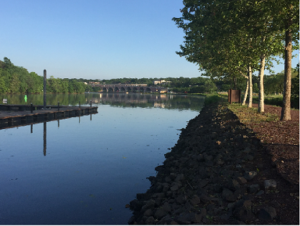Call for Proposals
coLAB Arts and the Lower Raritan Watershed Partnership are seeking submissions for proposals for new works of found object sculpture using items of trash collected from the Lower Raritan Watershed (The Raritan River and its tributaries).
What is the Watershed Sculpture Project?
This project is the result of a partnership between coLAB Arts and the Lower Raritan Watershed Partnership (LRWP). Our organizations seek to create awareness of the maturing visual arts scene in the Lower Raritan Watershed as well as the need for community involvement to restore local environmental health. coLAB Arts and LRWP coordinate volunteer clean-ups of area streams and from the refuse collected we identify objects to give to commissioned artists who then create original sculptures for public display.
2016 Commission Theme
In 2016 The Watershed Sculpture Project will work with the theme of “Frames.” We ask that all proposals incorporate this idea literally in the creation of a sculpture that frames the landscape and can be installed semi permanently along the Raritan River Waterfront at Boyd Park in New Brunswick. Additionally, we hope the work “frames” a conversation on how viewers can interact in more positive ways with New Jersey’s largest major waterway.

Sample image of framing landscape concept
2016 Commission Fee
$150
Materials
Examples of previous year’s materials may be found here: http://www.colab-arts.org/watershedsculptureproject/ Materials sourced have included, plastic bottles, shopping carts, wood, children’s toys, broken ceramics and glass, etc. coLAB Arts and LRWP have stockpiled a small collection of usable materials from previous clean-ups but will also organize a 2016 clean-up toward the end of August 2016 based on interest from selected artists. Because of project goals we ask that artists be cognizant of making their projects entirely or almost entirely of collected clean-up items. In addition, we ask artists to consider not using toxic adhesives or paints.
Display Requirements
September 25 – Raritan River Festival, Boyd Park
October 1 – “Watershed Moment” event Boyd Park
Winter – Fall 2017 Watershed Gallery, Wellness Plaza, New Brunswick
All sculptures will be displayed for two major events one week apart in Boyd Park in New Brunswick. Final sculptures should be constructed to survive in the park semi-permanently during the fall months. All work will then also have a year-long display at our permanent lobby-style gallery space in the Wellness Center Plaza in New Brunswick.

Boyd Park Waterfront in New Brunswick, NJ
Contact
Please submit a simple proposal idea by August 15 2016 to:
John Keller
Director of Education and Outreach
Curator, Watershed Sculpture Project
jpkeller@colab-arts.org
(732) 718 – 7614
The LRWP has submitted the following letter in response to NOAA’s Invitation to Public Comment on their “Restoration Plan/ Environmental Assessment Draft (RP/EA) for the American Cyanamid Co. Superfund Site, Bridgewater Township, Somerset County, New Jersey”:
May 23, 2016
Carl Alderson
NOAA Restoration Center – Sandy Hook Office
JJ Howard National Marine Fisheries Science Center
74 Magruder Rd, Highlands, NJ 07732
RE: American Cyanamid Draft RP/EA
Dear Mr. Alderson –
The Lower Raritan Watershed Partnership has reviewed NOAA’s proposed Restoration Plan/ Environmental Assessment (RP/EA) for the American Cyanamid Co. Superfund Site, Bridgewater Township, Somerset County, New Jersey and fully supports the proposal for primary and compensatory restoration activities.
The LRWP is New Jersey’s newest watershed association, formed in 2014 to address legacy contamination and current pollution in the Raritan River and the Lower Raritan Watershed. Our mission is to conserve, enhance and restore the natural resources of the New Jersey Watershed Management Area 9, the Lower Raritan Watershed. We believe that not only will removal of the Weston Mill Dam on the Millstone River directly improve resources impacted by legacy contamination, it is our understanding that the proposed project will benefit a broad spectrum of the Raritan River’s ecology and will likewise enable other environmental and human use benefits. Significant ecological, environmental and human use benefits have in fact already been realized following recent removal of a series of dams (Robert Street, Nevius Street and Calco) on the lower portion of the Raritan River between the towns of Bridgewater and Bound Brook. Likewise, we expect that design of technical fish passage at the Island Farm Weir (located on the Raritan River) will advance multiple Lower Raritan Watershed stakeholder goals.
The LRWP is also aware that the removal of the Weston Mill Dam on the Millstone River, as well as future modifications at the Island Farm Weir to include a technical fish passage at the Island Farm Weir on the Raritan River, will expand access to several thousand acres of non-tidal freshwater mid to upper reaches of the Raritan River’s major tributaries. Removal of Weston Mill Dam and the construction of a technical fish passage at Island Farm Weir will significantly enhance maturation and rearing habitat for striped bass, American shad, American eel, blueback herring, and alewife, and should significantly increase the abundance of anadromous and catadromous species, which will improve the ecological health of the Raritan River.
The LRWP’s only concerns with NOAA’s proposal are short term sediment transport impacts following dam removal. However, we are confident that NOAA’s plan to reduce potential environmental consequences is sound and further expect that the proposed projects will provide long term restorative benefits to water chemistry, specifically decreased water temperatures in formerly impounded sections, and increased dissolved oxygen concentrations. These changes will benefit riverine biota from the most basic food chain level up to the top predators for many years to come.
Enhancing fish populations in the Raritan River system is important for fresh and marine ecosystems. It is especially appropriate as the National Marine Fisheries Service (NMFS) lists the estuarine portion of the Raritan River as an important migratory pathway for anadromous alewife and blueback herring, species which NOAA lists as of special concern. The Lower Raritan Watershed Partnership feels that the proposed projects could help to reverse declining population trends, and anadromous fish returning to spawn each spring in the Raritan River provide an attraction to the general public in the Raritan River Basin. The removal of the Weston Mill Dam on the Millstone River and feasibility analysis and design of technical fish passage at the Island Farm Weir are important to the LRWP and we fully support the proposed projects.
Sincerely,
Heather Fenyk, Ph.D., AICP/PP
President, Lower Raritan Watershed Partnership
www.lowerraritanwatershed.org
The National Oceanic and Atmospheric Administration, the Department of Interior, and the State of New Jersey invite public comment on a proposed plan.
The Draft RP/EA is available at the following website:
http://darrp.noaa.gov/hazardous-waste/american-cyanamid
The public comment period on this plan ends June 10, 2016.
To request further information or an additional hard copy of this document or to submit your comments, please contact Carl Alderson at (732)371-0848, NOAA Restoration Center – Sandy Hook Office, JJ Howard National Marine Fisheries Science Center, 74 Magruder Rd, Highlands, NJ 07732 or by email at Carl.Alderson@noaa.gov. Please put “American Cyanamid Draft RP/EA” in the subject line.


